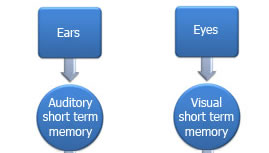3. Input sensors and short term memory

The model begins with the idea that our eyes and ears are input sensors. Ears provide audio information and our eyes provide visual information.
Each of these inputs are treated as separate channels. As shown below

The first thing that happens is that the information is stored in very short term (almost fleeting) memory. Memories decay very quickly at this stage, with visual information held for about 70-1000 milliseconds and the audio information held for about 1 - 4 seconds. Unless this information is processed further, it just decays away.
For example, if you were fully occupied in a task and a very brief sound pipes up from the interface, unless you pay immediate attention to it, you will forget or even fail to notice it..
challenge see if you can find out one extra fact on this topic that we haven't already told you
Click on this link: HCI and short term memory
